1989 MITSUBISHI GALANT light
[x] Cancel search: lightPage 1006 of 1273
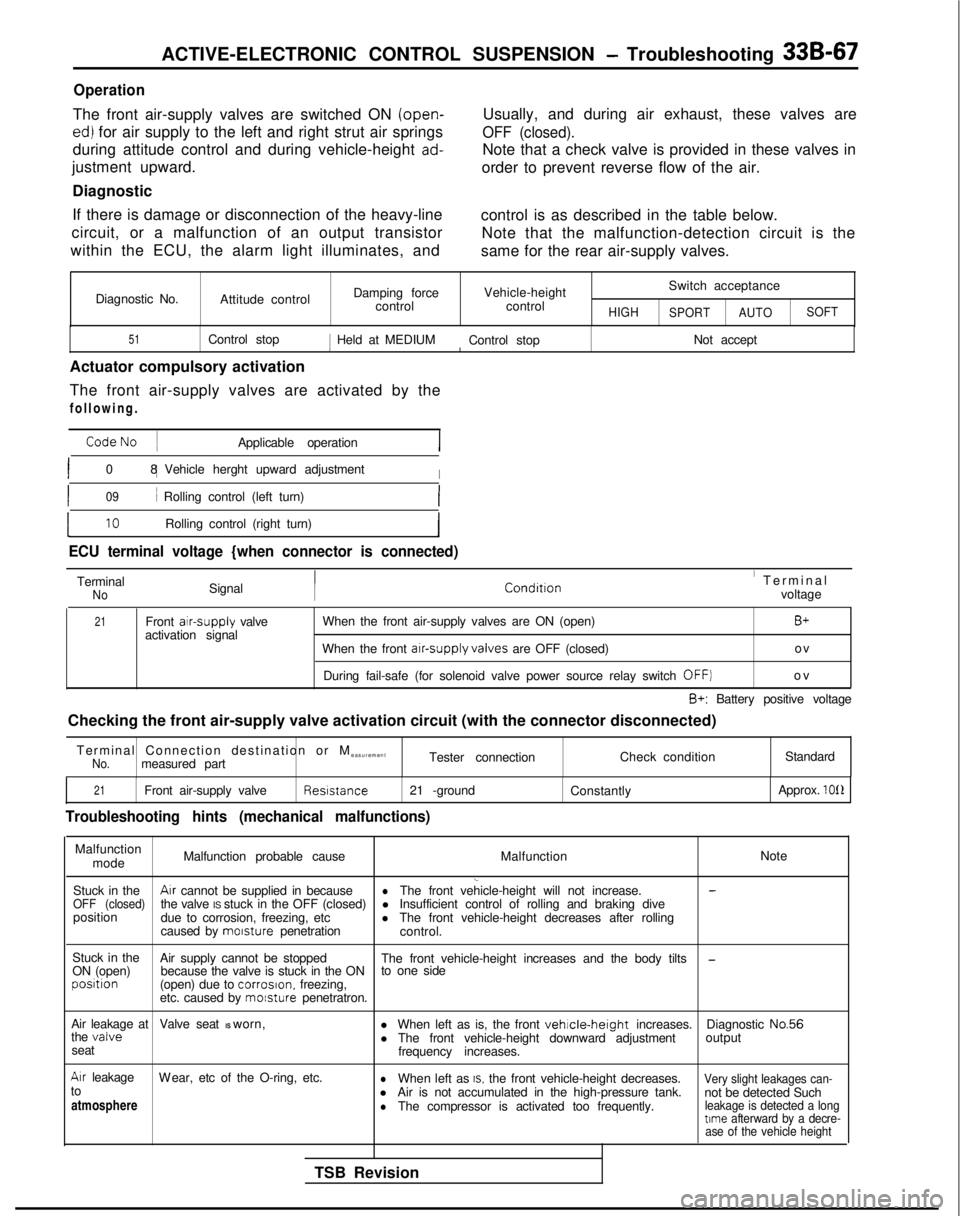
ACTIVE-ELECTRONIC CONTROL SUSPENSION - Troubleshooting 33B-67
Operation
The front air-supply valves are switched ON (open-
ed) for air supply to the left and right strut air springs
during attitude control and during vehicle-height
ad-
justment upward.
Diagnostic
If there is damage or disconnection of the heavy-line
circuit, or a malfunction of an output transistor
within the ECU, the alarm light illuminates, and Usually, and during air exhaust, these valves are
OFF (closed).
Note that a check valve is provided in these valves in
order to prevent reverse flow of the air.
control is as described in the table below. Note that the malfunction-detection circuit is the
same for the rear air-supply valves.
Diagnostic No. Attitude control Damping force
control Vehicle-height
control
HIGH
Switch acceptance
SPORT AUTOSOFT
51Control stop1 Held at MEDIUM
Control stop Not acceptI
Actuator compulsory activation
The front air-supply valves are activated by the
following
.
CodeNo
~
Applicable operation
I0
8 1
Vehicle herght upward adjustment
I
I09i Rolling control (left turn)I
L10Rolling control (right turn)I
ECU terminal voltage {when connector is connected)
TerminalNoSignal Conditron’ Termina
l
voltage
21Front atr-supply
valve
activation signal When the front air-supply valves are ON (open)B+
When the front arr-supply valves
are OFF (closed) ov
During fail-safe (for solenoid valve power source relay switch
OFF]o
v
B+: Battery positive voltage
Checking the front air-supply valve activation circuit (with the connec\
tor disconnected)
Terminal Connection destination or M easurement
No.measured part Tester connection
Check conditionStandard
21Front air-supply valve Resrstance
21 -ground
Constantly Approx. 1011
Troubleshooting hints (mechanical malfunctions)
Malfunction
mode Malfunction probable cause
MalfunctionNote
l Insufficient control of rolling and braking dive
position due to corrosion, freezing, etc lThe front vehicle-height decreases after rolling
caused by morsture
penetration
control.
Stuck in the Air supply cannot be stopped
ON (open) The front vehicle-height increases and the body tilts
-because the valve is stuck in the ON
to one sideposrtion
(open) due to corrosron.
freezing,
etc. caused by morsture
penetratron.
Air leakage at Valve seat IS worn,
l When left as is, the front
vehrcle-height increases.Diagnostic No.56
the valvel The front vehicle-height downward adjustment output
seat frequency increases.
Arr leakageW
ear, etc of the O-ring, etc.
lWhen left as IS. the front vehicle-height decreases.Very slight leakages can-to
l not be detected Such
atmosphere Air is not accumulated in the high-pressure tank.lThe compressor is activated too frequently.leakage is detected a longtime
afterward by a decre-
ase of the vehicle height
TSB Revision
Page 1008 of 1273
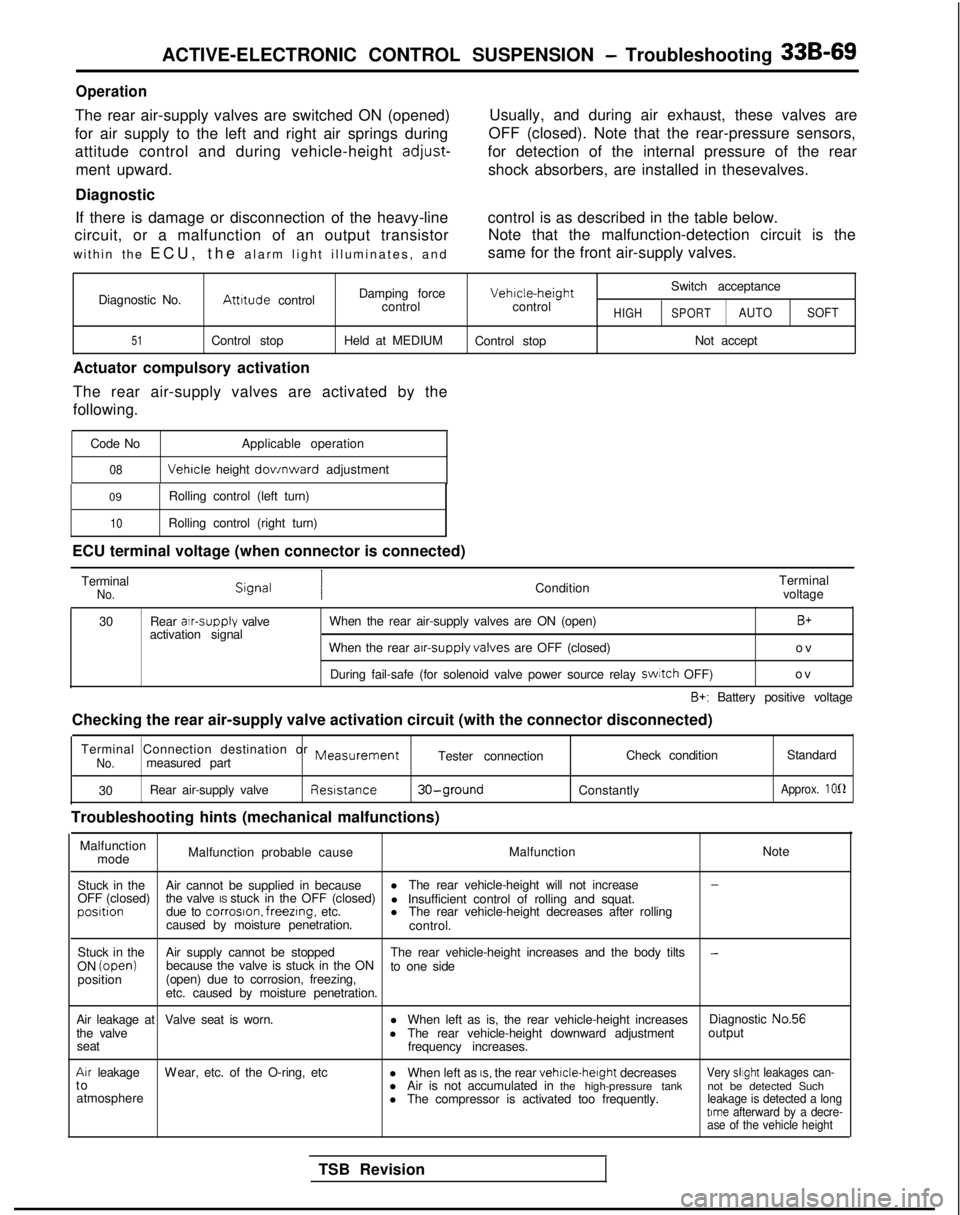
ACTIVE-ELECTRONIC CONTROL SUSPENSION - Troubleshooting 33B-69
Operation
The rear air-supply valves are switched ON (opened)
for air supply to the left and right air springs during
attitude control and during vehicle-height
adjust-
ment upward.
Diagnostic Usually, and during air exhaust, these valves are
OFF (closed). Note that the rear-pressure sensors,
for detection of the internal pressure of the rear shock absorbers, are installed in thesevalves.
If there is damage or disconnection of the heavy-line control is as described in the table below.
circuit, or a malfunction of an output transistor Note that the malfunction-detection circuit is the
within the ECU, the alarm light illuminates, and same for the front air-supply valves.
Switch acceptance
Diagnostic No.
Attrtude control Damping force Vehrcle-height
control controlHIGHSPORTAUTO SOFT
51Control stop Held at MEDIUM
Control stop Not accept
Actuator compulsory activation
The rear air-supply valves are activated by the
following.
Code No Applicable operation
08 Vehicle
height dov/nward adjustment
09 Rolling control (left turn)
10Rolling control (right turn)
ECU terminal voltage (when connector is connected)
Terminal
No.Condition Terminal
voltage
30 Rear alr-supply
valve
activation signal When the rear air-supply valves are ON (open)
B+
When the rear arr-supply valves
are OFF (closed) ov
During fail-safe (for solenoid valve power source relay switch
OFF) ov
B+: Battery positive voltage
Checking the rear air-supply valve activation circuit (with the connect\
or disconnected)
Terminal Connection destination or
MeasurementNo.measured part Tester connection
Check condition
Standard
30 Rear air-supply valve Reststance
30-ground
Troubleshooting hints (mechanical malfunctions)
Constantly
Approx. 1012
Malfunction
mode Malfunction probable cause
MalfunctionNote
Stuck in the Air cannot be supplied in because l
The rear vehicle-height will not increase
-
OFF (closed) the valve IS stuck in the OFF (closed)
l Insufficient control of rolling and squat.posrtion
due to corroson. freezrng,
etc. lThe rear vehicle-height decreases after rolling
caused by moisture penetration. control.
Stuck in the Air supply cannot be stopped The rear vehicle-height increases and the body tilts
-ON (open)
because the valve is stuck in the ON
to one side
position (open) due to corrosion, freezing,
etc. caused by moisture penetration.
Air leakage at Valve seat is worn. lWhen left as is, the rear vehicle-height increases Diagnostic No.56
the valve lThe rear vehicle-height downward adjustment output
seat frequency increases.
Arr leakageW
ear, etc. of the O-ring, etc
lWhen left as
IS, the rear vehrcle-height
decreasesVery slrght leakages can-t
o
lAir is not accumulated in the high-pressure tank not be detected Such
atmosphere lThe compressor is activated too frequently.
leakage is detected a longtrme afterward by a decre-
ase of the vehicle height
TSB Revision
Page 1010 of 1273

ACTIVE-ELECTRONIC CONTROL SUSPENSION - Troubleshooting 33B-71
Operation
The left front and right front valves are for switching
the air intake and exhaust for the left front and right
front strut air springs. These valves are usually,
Diagnostic and during air intake, OFF (closed), and are ON
(open) during exhaust.
If there is damage or disconnection of the heavy-line control is as described in the table below.
circuit, or a malfunction of an output transistor Note that the malfunction-detection circuit is the
within the ECU, the alarm light illuminates, and same for the left front and right front valves.
Diagnostic No.
52
Damping forceVehicle-herghtSwitch acceptance
Attitude control controlcontrol
HIGH
SPORT AUTOSOFT
Control stop
Held at MEDIUM Control stop Not accept
Actuator compulsory activation
The left front and right front valves are activated by
the following.
Code No. Applicable operation
07Vehicle height aownward adjustment
09.10 Rolling control (left turning: left
valve)/rollingcontrol (rrght turning: right valve)
ECU terminal voltages (when connector is connected] Termrnal
No
Slgnal
ConditionTerminal
voltage
3Left front valve activatron
When the left/right front valves are ONB+srgnal~ When the left/right front valves are OFF o
v
4Right front valve
activatronsrgnalDuring fail-safe (for solenoid valve power source relay switch OFF)
o
v
B+: Battery positive voltage
Checking the left front/right front valves activation circuit (with the\
connector disconnected)
I No. Terminal
Connection destination or
Measurement
Imeasured part Tester connection
Check conditionStandard
3Left front valve Resrstance3-groundConstantly
Approx 1012
4Right front valve
Resistance4-groundConstantly Approx 1012
Troubleshooting hints (mechanical malfunctions)Malfunctron
mode
Stuck
In the
OFF (closed)
position
Stuck
In the
ON (open) oositron
Air leakage at valve seat
Air leakage tc
atmosphere
!
Malfunction probable cause Malfunction
NoteAir
cannot be discharged because
l-
the valve is stuck in the OFF (closed) The left front and right front vehicle height
due to corrosion, freezing, etc. increases after rolling control.0Insufficient active control effect.
caused by moisture penetration.
Air cannot be taken in because the
lvalve is stuck in the ON (open) due The left front and right front vehicle height
Diagnostic trouble
decreases, and the body tilts to one side.
to corrosion. freezing, etc. caused code No.56 is output.lThe return pump is activated too frequently.
by moisture penetration
Valve seat is worn
W
ear, etc of the O-ring, etc
When left as is, the front vehicle-height will
decrease. Diagnostic trouble
code No.56 is output.
When left as is. the front vehicle-height will decrease.
Very slight leakages can-not be detected. Such
leakage IS detected a longtime afterward by a decre- ase of the vehicle height
TSB Revision
Page 1012 of 1273

ACTIVE-ELECTRONIC CONTROL SUSPENSION - Troubleshooting 33B-73
Operation
The left rear and right rear valves are for switching
the air supply and exhaust for the left rear and right rear shock absorber air springs. These valves are
Diagnostic usually, and during air supply, OFF (closed), and are
ON (open) during exhaust.
If there is damage or disconnection of the heavy-line
circuit, or a malfunction of an output transistor
within the ECU, the alarm light illuminates, and control is as described in the table below.
Note that the malfunction-detection circuit is the
same for the left rear and right rear valves.
Diagnostic No.
53
Damping force Vehicle-height Switch acceptance
Attitude control controlcontrol
HIGHSPORTAUTOSOFT
Control stop
Held at MEDIUMControl stop Not accept
Actuator compulsory activation
The left rear and right rear valves are activated by
the following.
Code No. Applicable operation
I07/ Vehicle height downward adjustmentI
09.1
0
Rolling control (left turning, left
valve)/rollingcontrol (right
turning: right valve)
ECU terminal voltages (when connector is connected) Terminal
No.Signal ConditionTerminal
voltage
29 Left rear valve activation When the left/right rear valves are ON
signal
E3a3azg~ positive
~ When the left/right rear valves are OFF o
v
27 Right rear valve activation
signal During fail-safe (for solenoid valve power source relay switch OFF) ov
Checking the left rear/right rear valves activation circuit (with
the connector disconnected)
Terminal Connection destination or
MeasurementNo.measured part Tester connection
29 Left rear valve Resistance
29-ground
27Right rear valve
Resistance27-ground
Troubleshooting hints (mechanical malfunctions) Check condition
Constantly
Constantly Standard
Approx
1011
Approx. 1 Of2
Malfunction mode Malfunction probable cause
IMalfunction
Note
Stuck in the
OFF (closed)
position
Stuck in the
ON (open)
position
Air leakage
at valve seat
Air leakage
tcatmosphere Air cannot be discharged because
l
The left rear and right rear vehicle height
the valve is stuck in the OFF (closed)
increases after rolling control.
due to corrosion, freezing, etc. 0
Insufficient active control effect.
caused by moisture penetration.
Air cannot be taken in because the
lThe left rear and right rear vehicle height
valve is stuck in the ON (open) due decreases, and the body tilts to one side.
to corrosion, freezing, etc caused l
The return pump is activated too frequently
by moisture penetration.
Valve seat is worn. When left as is, the rear vehicle-height will decrease.
W
ear, etc. of the O-ring, etc.
When left as is, the rear vehicle-height will decrease.
TSB Revision Diagnostic trouble
code
No.56 is output
Diagnostic trouble
code
No.56 is output
Very slight leakages can- not be detected. Such
leakage is detected a long
time afterward by a decre- ase of the vehicle height.
Page 1017 of 1273
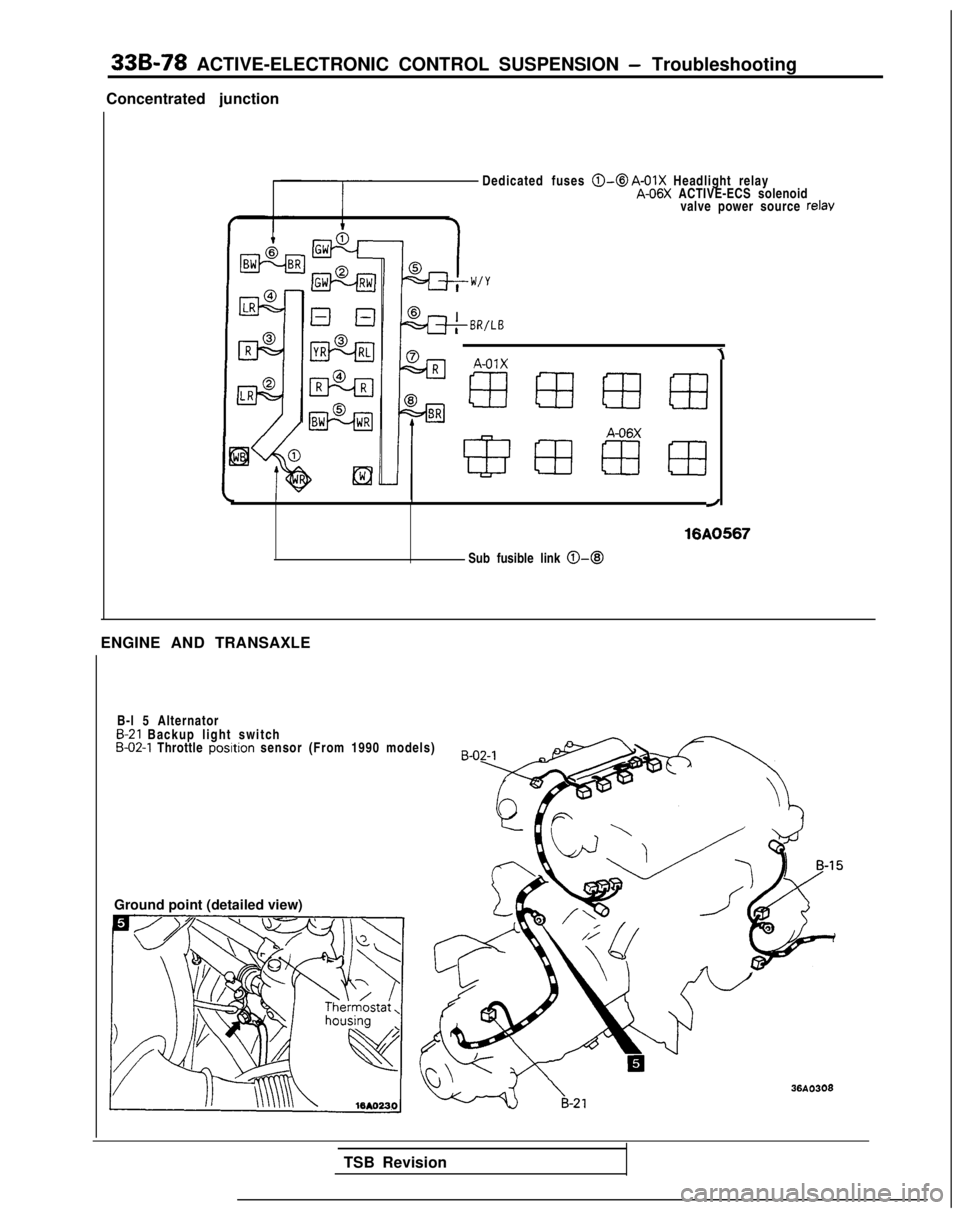
336-78 ACTIVE-ELECTRONIC CONTROL SUSPENSION - Troubleshooting
Concentrated junction
Dedicated fuses
@I-@ A-01X Headlight relayA-06X ACTIVE-ECS solenoidvalve power source relay
‘\
I,BR/LB
A-01X
\
8383mB
Sub fusible link 0-a
/
16A0567
ENGINE AND TRANSAXLE
B-l 5 Alternator
B-21 Backup light switchB-02-1 Throttle posltion
sensor (From 1990 models)
Ground point (detailed view)
36A0308
TSB Revision
Page 1019 of 1273
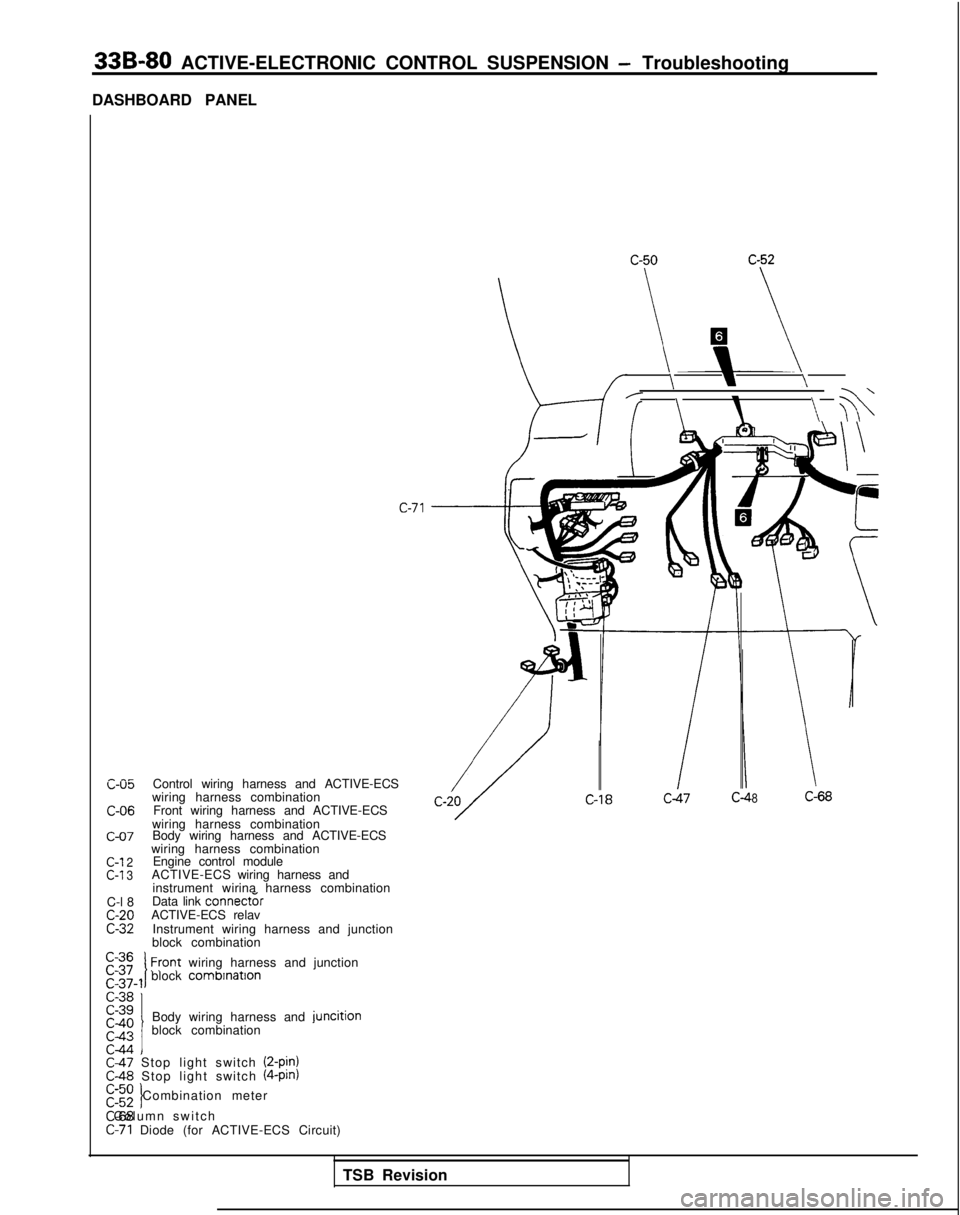
33B-80 ACTIVE-ELECTRONIC CONTROL SUSPENSION - Troubleshooting
DASHBOARD PANEL
c-05 C-06
c-07
C-l
2
C-l 3
C-l 8c-20C-32
Control wiring harness and ACTIVE-ECS
wiring harness combination Front wiring harness and ACTIVE-ECS
wiring harness combination Body wiring harness and ACTIVE-ECS
wiring harness combination Engine control module
ACTIVE-ECS wiring harness and
instrument wirina harness combination
Data link
connect&ACTIVE-ECS relav
Instrument wiring harness and junction
block combination C-36
block
combrnatlon1 Front
wiring harness and junction
Body wiring harness and
juncitionblock combination
C-47 Stop light switch (2-pjn)rC&$ Stop light switch (4-pin)
c-52 Combination metert C-68 Column switch
C-71 Diode (for ACTIVE-ECS Circuit)
\\\/
/\\ ?b
c-71
-If8C-68
TSB Revision
Page 1026 of 1273
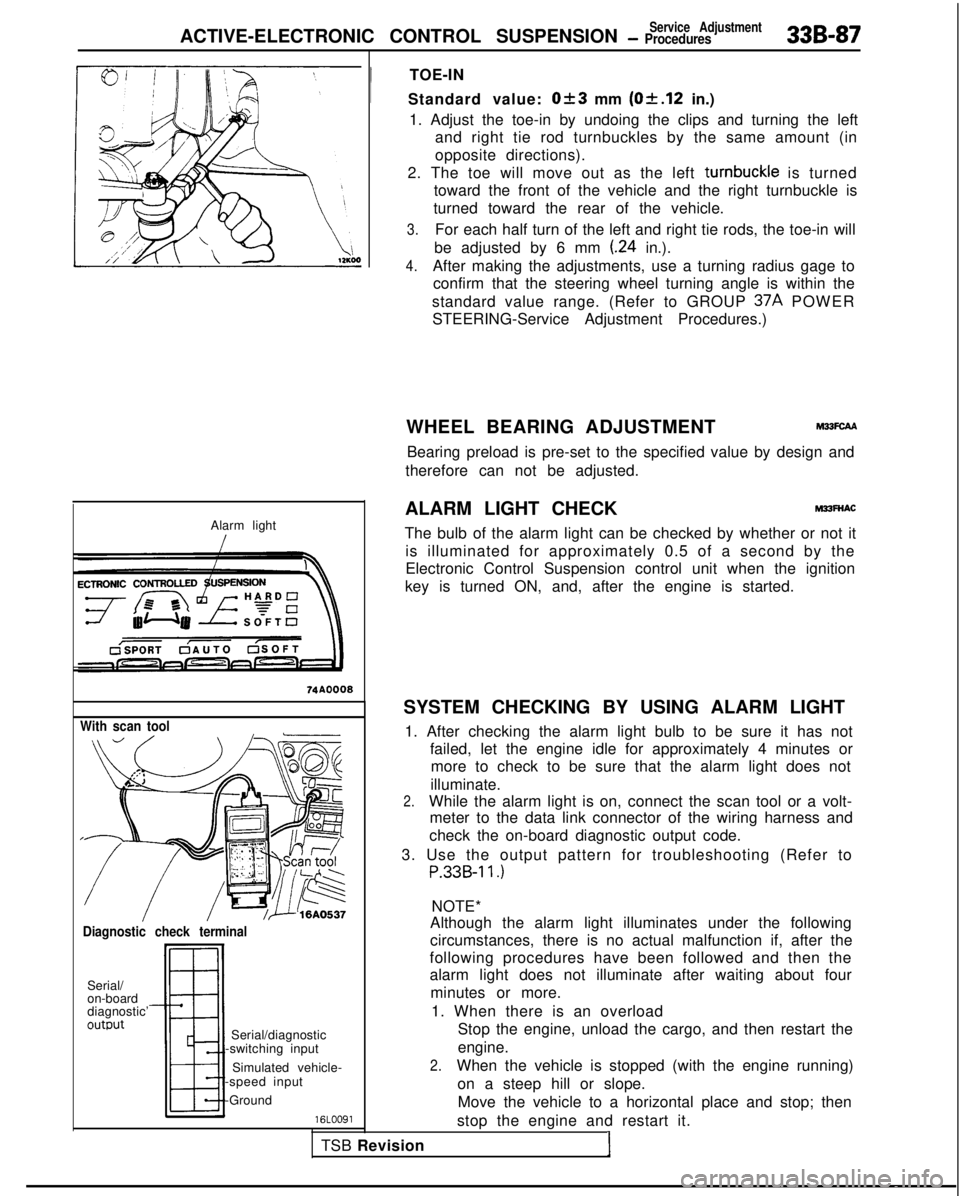
ACTIVE-ELECTRONIC CONTROL SUSPENSIONService Adjustment- Procedures33B-87
Alarm light
With scan tool
Diagnostic check terminal
Serial/
on-board
diagnostic’
outwt
TSB RevisionI
Serial/diagnostic
-switching input
Simulated vehicle-
-speed input
-Ground
16LOO91
!
TOE-IN
Standard value:
Ok3 mm (Of.12 in.)
1. Adjust the toe-in by undoing the clips and turning the left and right tie rod turnbuckles by the same amount (in
opposite directions).
2. The toe will move out as the left turnbuckle
is turned
toward the front of the vehicle and the right turnbuckle is
turned toward the rear of the vehicle.
3.For each half turn of the left and right tie rods, the toe-in will
be adjusted by 6 mm
(.24 in.).
4.After making the adjustments, use a turning radius gage to confirm that the steering wheel turning angle is within the
standard value range. (Refer to GROUP 37A
POWER
STEERING-Service Adjustment Procedures.)
WHEEL BEARING ADJUSTMENT
M33FcAA
Bearing preload is pre-set to the specified value by design and
therefore can not be adjusted.
ALARM LIGHT CHECK
MPFNAC
The bulb of the alarm light can be checked by whether or not it is illuminated for approximately 0.5 of a second by the
Electronic Control Suspension control unit when the ignition
key is turned ON, and, after the engine is started.
SYSTEM CHECKING BY USING ALARM LIGHT 1. After checking the alarm light bulb to be sure it has not failed, let the engine idle for approximately 4 minutes ormore to check to be sure that the alarm light does not
illuminate.
2.While the alarm light is on, connect the scan tool or a volt- meter to the data link connector of the wiring harness and
check the on-board diagnostic output code.
3. Use the output pattern for troubleshooting (Refer to
P.33B-11.)
NOTE*
Although the alarm light illuminates under the following
circumstances, there is no actual malfunction if, after the
following procedures have been followed and then the
alarm light does not illuminate after waiting about four
minutes or more.
1. When there is an overload Stop the engine, unload the cargo, and then restart the
engine.
2.When the vehicle is stopped (with the engine running)
on a steep hill or slope.Move the vehicle to a horizontal place and stop; then
stop the engine and restart it.
Page 1027 of 1273
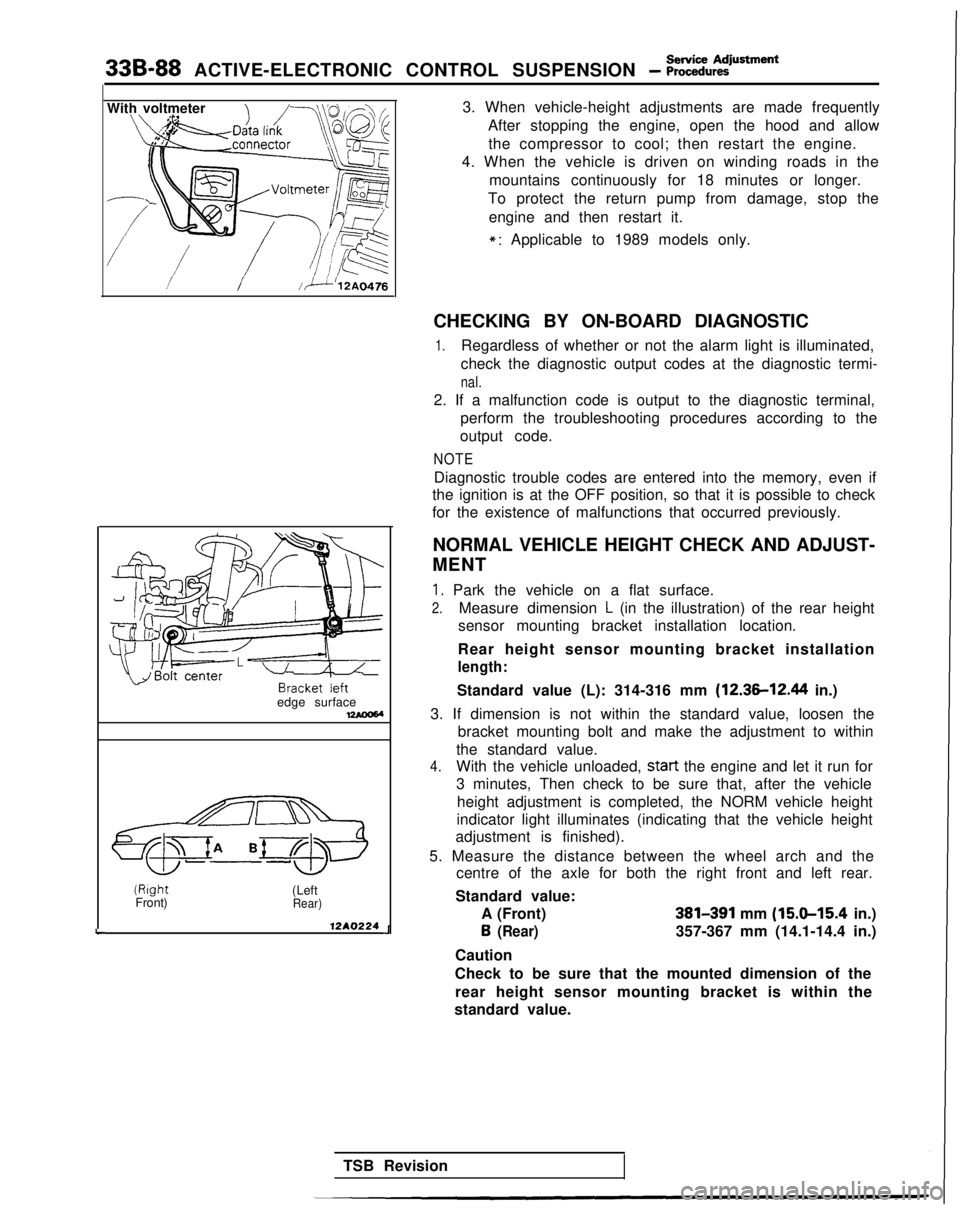
338-88 ACTIVE-ELECTRONIC CONTROL SUSPENSION - ~~~%.,~Rment
With voltmeter
!//ii’12A0476
L
edge surface17AOOW(Right
Front) (Left
Rear)
12A0224 J3. When vehicle-height adjustments are made frequently
After stopping the engine, open the hood and allowthe compressor to cool; then restart the engine.
4. When the vehicle is driven on winding roads in the
mountains continuously for 18 minutes or longer.
To protect the return pump from damage, stop the
engine and then restart it.
*: Applicable to 1989 models only.
CHECKING BY ON-BOARD DIAGNOSTIC
1.Regardless of whether or not the alarm light is illuminated,
check the diagnostic output codes at the diagnostic termi-
nal.
2. If a malfunction code is output to the diagnostic terminal, perform the troubleshooting procedures according to the
output code.
NOTE
Diagnostic trouble codes are entered into the memory, even if
the ignition is at the OFF position, so that it is possible to check
for the existence of malfunctions that occurred previously.
NORMAL VEHICLE HEIGHT CHECK AND ADJUST-
MENT
1. Park the vehicle on a flat surface.
2.Measure dimension L (in the illustration) of the rear height
sensor mounting bracket installation location.
Rear height sensor mounting bracket installation
length:
Standard value (L): 314-316 mm (12.36-12.44 in.)
3. If dimension is not within the standard value, loosen the bracket mounting bolt and make the adjustment to within
the standard value.
4.With the vehicle unloaded, start
the engine and let it run for
3 minutes, Then check to be sure that, after the vehicle
height adjustment is completed, the NORM vehicle height
indicator light illuminates (indicating that the vehicle height
adjustment is finished).
5. Measure the distance between the wheel arch and the centre of the axle for both the right front and left rear.
Standard value: A (Front)
381391 mm (15.9-15.4 in.) 6
(Rear)357-367 mm (14.1-14.4 in.)
Caution
Check to be sure that the mounted dimension of the rear height sensor mounting bracket is within the
standard value.
TSB Revision